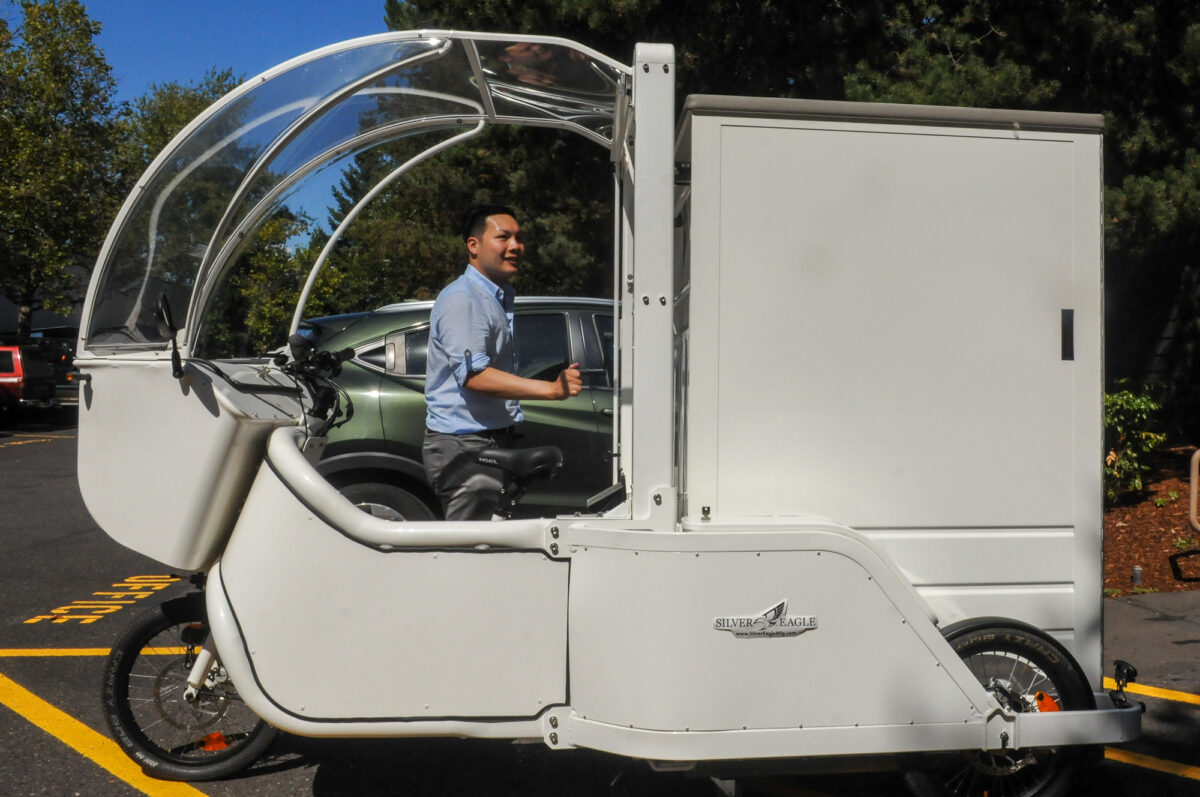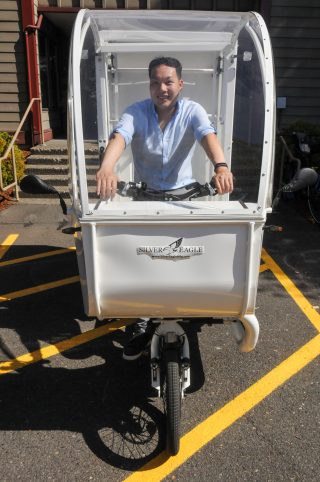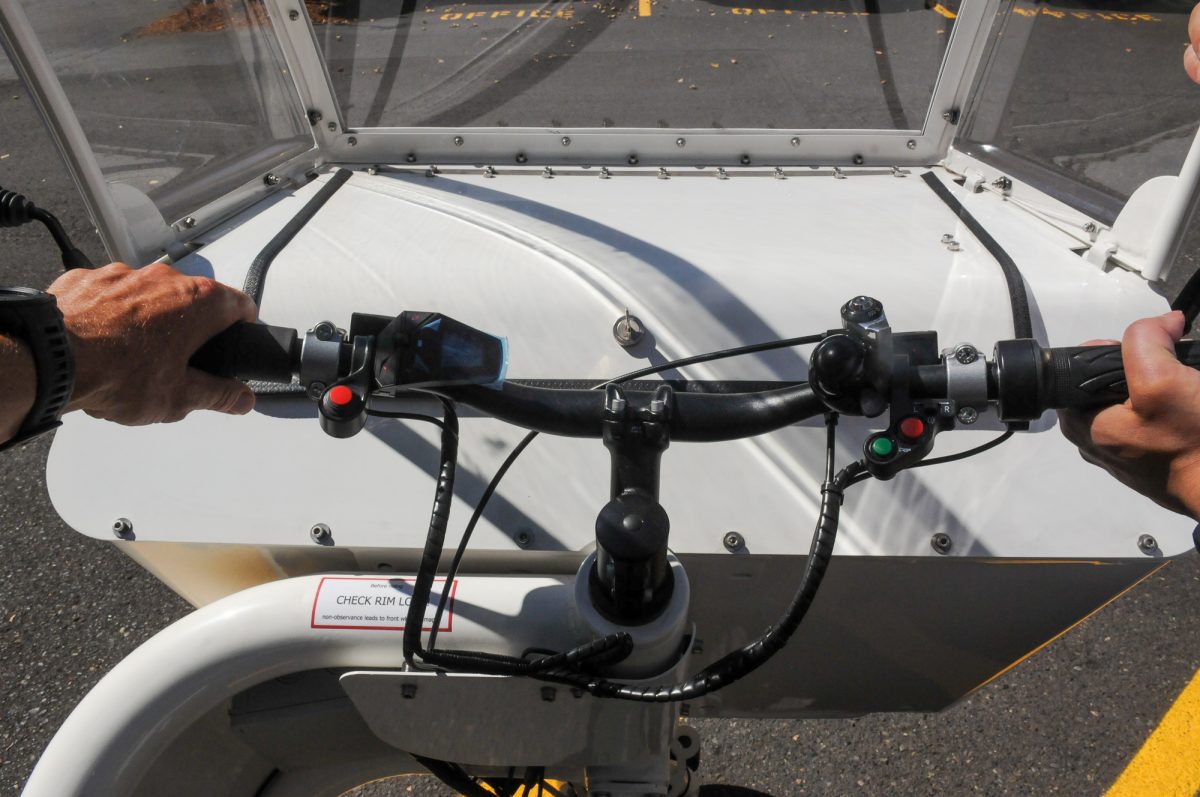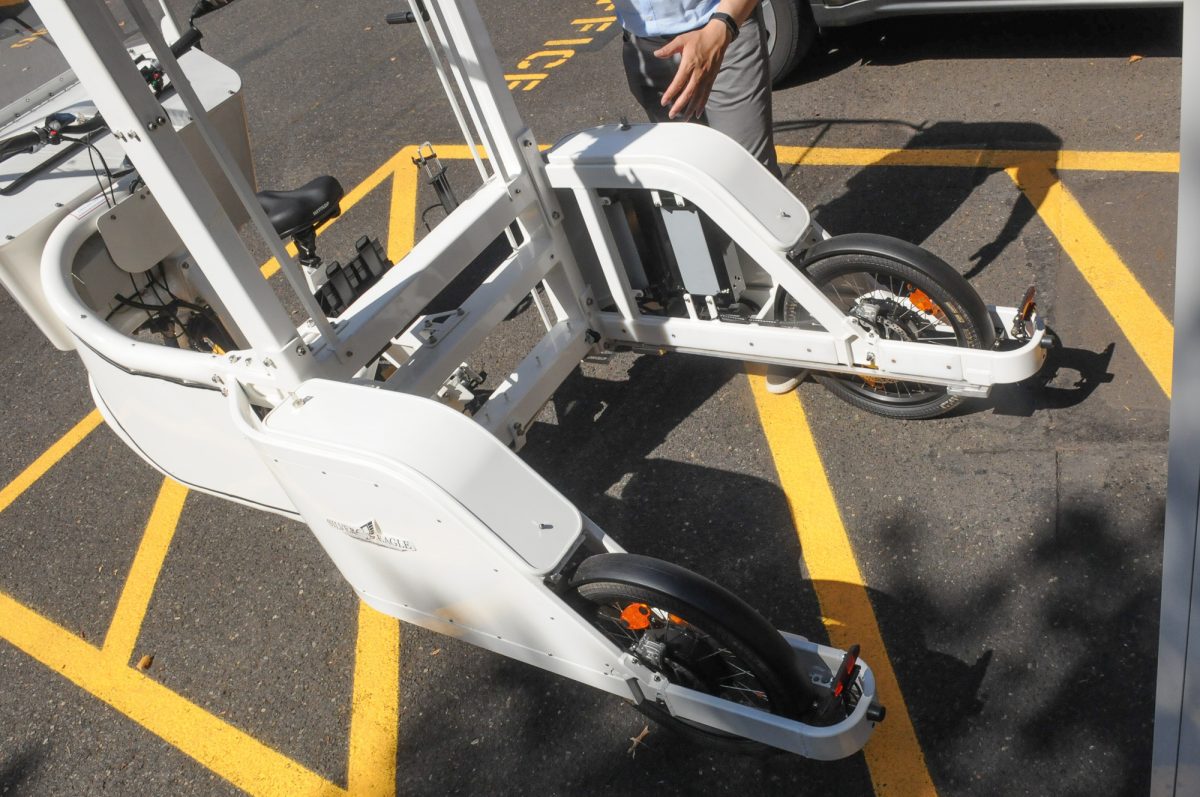
(Photos: J. Maus/BikePortland)
A Portland manufacturing company is confident that a pedal-assisted, light electric vehicle can play a big role in the future of urban delivery. Since January of this year, Silver Eagle Manufacturing in northeast Portland has carved out space in their large factory for a three-wheeled cargo trike that can haul up to 400 pounds and runs on two legs and two lithium-ion batteries.
One of the main reasons they’re so bullish on this vehicle? At just 48-inches wide, the trike is fully bike lane legal. That means a rider can haul its 60 cubic foot cargo box around the city without worrying about congestion.
Silver Eagle has purchased the U.S. rights to produce and sell the MovR, which was developed by Rytle, a company based in Germany. The MovR weighs nearly 300 pounds (without a rider) and with its stout aluminum frame it rides more like a tiny truck than a large trike. In addition to two independent hub motors on the rear wheels (which means no drivetrain axle needed to connect them), the MovR has a throttle (which comes in handy at dead stops), turn signals, and even a reverse mode. Speed tops out at 15 mph.
Michael Chen is Silver Eagle’s marketing guy. He sees this as the future of last-mile delivery for companies large and small. During a recent demo of the trike, he said the MovR is a new direction for his 80-year-old company. Silver Eagle’s bread and butter are cargo trailers for the U.S. military and trailer parts for United Parcel Service (UPS). Instead of a bicycle-oriented company moving into the freight delivery/cargo market, Silver Eagle is a freight company moving into the pedal-powered realm. “In some ways, the MovR is punching under our belt, but it’s also something new for us. Everything is moving in this direction,” Chen shared.
Advertisement
(Video: Watch Chen reverse the MovR into place and attach the cargo box.)

The boom in online sales and Amazon’s delivery dominance has put pressure on the entire freight industry to invest in more efficient and innovative last-mile solutions.
Silver Eagle’s 40-year relationship with UPS is key to their future with the MovR. UPS has jumped into the pedal-powered last-mile delivery market with a pilot project launched last fall in Seattle which included a test of the locally designed Truck Trike made by Stites Design. UPS is actively using 30 MovR trikes in Germany (one of our readers spotted one on the streets of Munich last week) and Canadian delivery giant Purolator purchased 20 MovR trikes for its new delivery hub in Toronto.
Chen says it’s not just global delivery juggernauts that can benefit from the trikes. He’s looking for all types of buyers — from small businesses like bakeries and florists, to colleges who need to move cargo on a large campus. In addition to its impressive cargo capacity and much smaller footprint than a truck, because the MovR is a Class II electric bicycle, you don’t need a license or registration to operate it.
Speaking of operation, I got in and was able to take it for a spin down the street with relative ease. Unlike a truck, it corners and turns-around on a dime and I maneuvered through a cramped parking lot without stress.
Beyond just hauling cargo, the MovR can also leave it behind in a secure box. The box is detachable and has wheels so it can be unhinged from the trike and rolled onto elevators, up ramps, and left in storage areas. And at $18,000 (box included), some customers might want to take advantage of the 55 square feet of advertising space on the box’s side to recoup some of their investment.
This trike is just the latest vehicle looking to use Portland’s bike lanes. Portlanders on bikes already share these (mostly) carfree lanes with electric scooter users, e-boarders, one-wheelers, Biketown rebalancers, delivery riders from B-Line, Portland Pedal Power, and other courier companies, and so on. With the entry of trikes like the MovR, it’s probably time to rename bike lanes to something a bit more inclusive and make them wider and more connected so we can finally see their full people-and-cargo-moving potential
Learn more about the MovR on Silver Eagle’s website.
— Jonathan Maus: (503) 706-8804, @jonathan_maus on Twitter and jonathan@bikeportland.org
Never miss a story. Sign-up for the daily BP Headlines email.
BikePortland needs your support.














Thanks for reading.
BikePortland has served this community with independent community journalism since 2005. We rely on subscriptions from readers like you to survive. Your financial support is vital in keeping this valuable resource alive and well.
Please subscribe today to strengthen and expand our work.
I’m curious why this form of cargo transport doesn’t go fully electric with a 20 MPH governor (bike lane legal)? I like the pedal assist, but I don’t know how much I would use it if I had a throttle option.
You’d use pedal assist. Trust me. I have both.
The long and short of it is, it takes a massive amount of energy to move something that weighs as little as a bicycle and a person without pedaling. And that’s on flat ground. If you’re going up a hill, you’re going to need something like 3 kilowatts of power to haul any weight, and then your motor is going to overheat. The human aspect of electric biking is, in current popular culture, underrated and underestimated by those who haven’t attempted it yet.
Yeah, most people think an ebike does all the work. Couldn’t be further from the truth!
https://www.bicycling.com/news/a28819663/e-bike-fitness-levels-study/
It looks like a fairly large vehicle so I thought it might have a fairly large motor and battery…
How do the pedals work? Do they connect to the left rear wheel?
“At just 48-inches wide, the trike is fully bike lane legal. That means a rider can haul its 60 cubic foot cargo box around the city without worrying about congestion.”
a) Are your bike lanes down there always the full 5 feet wide? are the 2-way lanes a full 10 feet wide? Ours certainly aren’t.
b) It’s all well and good to not worry about being slowed by congestion, but what about causing congestion?
c) I understand that our transportation infrastructure gets the funding it does because of commerce, but does ever single inch of pavement have to be given over to it?
We still have a 20 inch wide bike lane. It’s on Beaverton-Hillsdale Highway at the county line, in front of Key Bank, if anyone is wondering.
https://goo.gl/maps/6hFmdBSyDZuRrdMGA
Fun fact: when they rebuilt and relandscaped the bank branch a few years ago, they ripped out and repoured the sidewalk – and repainted this criminally substandard bike lane the exact same width as before. On an 80 foot wide slab of pavement that constitutes the flattest, quickest bike route over the West Hills, ODOT can’t even be bothered to come up with a bike lane that is the width of my handlebar.
Not to be overly technical, but a bike lane is denoted with an 8-inch stripe. That there is a fog line. Feel free to take the lane! 🙂
Feel free to die! Trying to take the lane on BHH would be an excellent way to get into a deadly conflict with motorists, so no thanks. FWIW, I seem to recall a bike stencil closer to Oleson there, so it may actually be a bike lane.
I have a dream. Instead of cars we quickly transition to a system where urban citizens can have two transportation choices. They can ride bikes that they own and take to quick and convenient trains for long distances with bike hangers aboard or they can own or rent a “transpo pod” that fits on the back of one of these Trikes. It would have windows, and seats, and gadgets if desired. Then a quick tap to the smartphone would bring a pod trike to your location to pick up your pod ( quick attach tech, a few seconds). It would then take your pod (with you in it to your location) and drop it in one of the downsized parking spots previously used for cars, or drop you curbside and put your pod away in a storage unit for the day. Then for longer distance trips,or commutes from the burbs your pod would be quick attached to a pod train so your could ride any distance in the comfort of your personal pod. At the other end another Trike would take you to your final destination. The amount of room on the roads and in parking lots opened up by ditching cars and going to narrow bike and trike lanes would eliminate congestion and allow higher density. The removal of 4ooo lb oil and lithium burning beasts would save the planet and instead of having jobs displaced by robot cars ( technically qustionable) we would create thousands of jobs for Trike Drivers. And instead of having mega corps building the Trikes and Pods, have a special program that empowers thousands of worker owned coops to build the Trikes and Pods in every town and city. Lets get going and save the world.
In theory I like it, but not within the current framework of capitalism and the socioeconomic patterns that would continue in a system like this.
We can’t let that hold us back. Our current system was evolved to maximize growth, and income while using the most resources possible and thus outcompeted other systems. We now enter a phase of human habitation on the planet where we must shift to a system that minimizes resource use, enables a steady state economy and population base and builds the carrying capacity of the ecosystem instead of destroying it. Such a system will happen as our current one will probably not survive its impact with the oncoming bursting of the multiple bubbles that have been blown up ( debt, real estate, finance, etc.) over the last 40 years. Our current system of neoliberal, market based capitalism is on its last legs and we better be planning on a new horse to ride when this one collapses in the dust.
Oh I agree with you on all that. But personal little pods that people ride around in everywhere they go? That not only sounds pretty much like what we currently have but only is going to entrench the cast systems in America even more.
Personal pod transportation using a e trike means the labor input is over 100% of the rider’s commute time. They say transit is expensive because of labor costs? Pods would be a crazy luxury. Just keep it off the Broadway Bridge, ok?
Instead of this fancy pod business, why not empower the transit we already have, embodied energy included, with dedicated lanes, optimized traffic signals, and some really excellent stops and stations that have shelters, *bathrooms* are you still there Trimet? — and valet bike parking FFS. I don’t know about you but I’d much rather check bikes all day than haul somebody around on the back of a trike.
Now, a tandem taxi, that would be sort of fun. Not everybody is a good stoker, so yeah it’s an e bike.
I’m surprised this configuration of three wheel trike is still a thing… even in that video you can see one of the rear wheels lift off the ground when he is backing up. Sketchy… and that’s not even with the box of _lbs hooked onto the back. Having the front wheel that close to the center of the vehicle creates a lot of risk for tipping. Even with the weight of the box behind it “holding the back down” it also means there is that much weight above the center of mass pushing the top of the bike over the top of it’s balance point. No thanks.
Yeah, an unloaded pickup truck is light in the back. And that three wheel configuration is the least stable mode of vehicle (except for, perhaps, a unicycle). You’re also going to have a problem if that cargo box is top heavy or has liquids in it. These are also all good reasons to give this thing a lower top speed. 🙂 A good driver can mitigate these issues, I hope they give folks training.
Well, it does look more stable than a Reliant Robin:
https://www.youtube.com/watch?v=QQh56geU0X8
Helmet AND 4 point harness
2 cents, back on topic: This is not the evolution of a bike, this is the evolution of a motor vehicle. Bikes are already nimble, space efficient, able to transport a large multiple of their weight whether passengers or goods, and free of point source pollution.
This is the evolution of mechanized transport, period. It is apparently a trike mainly to qualify as a bike and use bike lanes. If there is any purpose for bike lanes, adding a class of vehicles that is many times heavier, double width, dynamically unstable, and wholly dependent on stored power defeats that purpose.